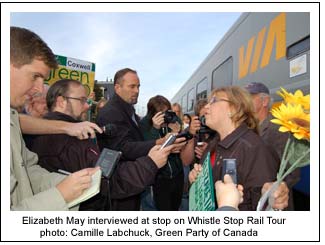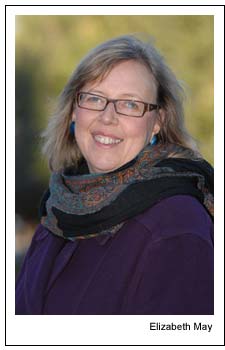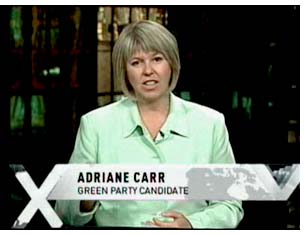Green Party of Canada reaches new heights in 2008 Federal Election
Share
“The Green Campaign functioned on two levels, promoting Green issues and demonstrating the credibility/capability of the Green Party, specifically its ability to manage the economy better than the Conservative government.” ñ†Elizabeth May
 by Mike Feinstein, International Committee of the Green Party of the United States
by Mike Feinstein, International Committee of the Green Party of the United States
In the October 14th federal election campaign, the Green Party of Canada (GPC) appeared in the party Leaders Debate for the first time and then won almost one million votes on Election day, seeing its percentage of the vote rise by more than 50 percent ó from 4.5 percent to 6.8 percent, its highest ever.
To what was this success owed? “The Green Campaign functioned on two levels,” said Green Party Leader Elizabeth May in an interview with Green Pages, “promoting Green issues and demonstrating the credibility/capability of the Green Party, specifically its ability to manage the economy better than the Conservative government.”
The GPC contested 303 out of 308 ridings (districts) across Canada and improved its percentage in 249 of them (82 percent), including 26 by 5 percent or more and six by 10 percent or more. Five campaigns placed second (up from one in 2006), led by May with 32.2 percent in Central Nova; and 40 of them placed third (up from two).
Vision Green††(see also this video) was the name of the GPC’s platform and offered, according to May, “meaningful action on the climate crisis, designed in such a way as to shift Canada to a green economy, including the core Green tax shift – reducing income and payroll taxes and placing them on pollution and greenhouse gases instead.” Vision Green called for a revenue-neutral $50/ton carbon tax, arguing that only a change on this level would be sufficient to promote needed environmental and economic goals.
The GPC also proposed to eliminate poverty through a guaranteed livable income, as well as to pursue nuclear disarmament, review Canada’s NATO commitments, strengthen its health care system and eliminate and/or tax toxic substances that compromise human and ecological health.
May’s 32.2 percent of the vote was the highest ever for a Green running for the House of Commons. Previously, the best result in a general election had been 16.7 percent by former GPC Deputy Leader Andrew Lewis in 2004 (Saanich-Gulf Islands. BC). In 2008 fourteen campaigns broke this high water, including Dick Himba with 27.2 percent (2nd/4 BruceñGreyñOwen Sound, ON), Mike Nagy 21.1 percent (3rd/4, Guelph, ON) and GPC Deputy Leader Adriane Carr with 18.3 percent (3rd/4, Vancouver Centre, BC.)
What makes these numbers particularly impressive compared to the U.S. is that in Canada, there are often three or four major parties the Greens must compete with in each riding. In the U.S., Greens have only achieved these percentages in two-way races against one of the major parties. In May’s case, she ran against the Conservatives and NDP (New Democratic Party), while the Liberals chose not to run. In the other races, Greens contested all three.
Whistle Stop Tour
On Sunday, September 21st, May began a whistle-stop train tour across Canada, crossing eight provinces to promote the Green Party’s message. Not since the 1960s had a federal leader campaigned by train from coast to coast, but according to May, it was an opportunity to show the Green Party did politics differently and that the party was looking to the future and acting responsibly.
“The whistle stop tour was undertaken for several reasons; 1) to ‘walk the talk’ and keep our carbon emissions low, aiming for a carbon neutral campaign. By comparison, we used less than one percent of the carbon the NDP used in its campaign, jetting across the country repeatedly, 2) to demonstrate our commitment to building and expanding rail service for passengers and freight. Our platform called for $1 billion in rail improvements, and 3) to provide the media with a different image from that of the other parties.”

According to May, attendance at many stops exceeded party expectations. “There were large rallies in places where we are well organized and the train arrived at a reasonable hour. There were more than 200 people in Vancouver, Winnipeg and Toronto, more than 150 in Halifax, and 100 in Edmonton. But there were even rallies in places where we had no Greens on the ground. In other words, the general public showed up on its own at stops across Canada, even in the middle of the night. There were 40 people in Kamloops, British Columbia at 3 AM, 80 people in Saskatoon, Saskatchewan at 1 AM and 40 in Millville, Saskatchewan at 5 AM.”
The David Suzuki Foundation also found the Green Party had the lowest carbon footprint of any of the major campaigns ñ producing only 2.5 tons of greenhouse gas emissions vs. the NDP: 586.1, Conservatives: 514.4 and Liberals: 503.4. By comparison, an average Canadian generates over five tons annually. All of the parties except the Conservatives purchased carbon-offset credits to compensate for their footprint.
Leaders Debate
Perhaps the biggest impact the Green Party made in the 2008 campaign was participating in the Leaders Debate for the first time ever. Traditionally Greens have been excluded from these debates on the federal and provincial level arguing, “only parties that already have Members of Parliament can be in the debates.”
But on August 30th, sitting independent British Columbia Member of Parliament (MP) Blair Wilson (West Vancouver – Sunshine Coast – Sea to Sky Country) joined the Green Party, stating: “I can make a real difference by ensuring Elizabeth May is included in the leaders’ debates. There is a democracy deficit in Canadian politics and this is one step in restoring effective democracy in Canada.”
Wilson’s action set off an unprecedented chain of events. First without contacting the GPC, the media consortium that puts on the debates sent out a press release saying May would not be allowed to participate because of boycott threats by the Conservatives, NDP and the Bloc QuÈbÈcois if she did.
This was followed by a threat of legal action by May, and a nationwide public outcry against the decision to exclude her, including a flurry of editorials and opinion pieces written in major papers across the country criticizing the major parties. Former Prime minister Joe Clark wrote an editorial in Toronto’s Globe and Mail entitled “Let Elizabeth Speak” condemning the threats as “blackmail.” Leading NDP activist Judy Rebick wrote her own piece there entitled “Barbarians at the Gate” saying it was in the interest of democracy May be allowed to debate and that she had never before been ashamed like now to be associated with her party.”
Former CBC News chief Tony Burman said Conservative Prime Minister Stephan Harper’s stance was cynical and self-serving calling for “Canadians to pull the plug on the networks and entrust this vital mission to an independent, non-partisan ‘commission’.” Tens of thousands of Canadians also signed on-line petitions and ultimately the public pressure caused the leaders to give in. On September 10th, the consortium announced May’s inclusion in the debates to be held October 1st and 2nd.
“The historic first Green participation in the debates gave me a chance to stress the depth and breadth of our platform and put the lie to the idea that we were a ‘one issue’ party,” said May.
Did she accomplish her goal?
The response the next day was overwhelmingly positive:
ï “Elizabeth May did a fantastic job. If you had to say there was a winner, it was probably Elizabeth May” – Jane Taber, Globe and Mail Senior Parliamentary Writer in the Ottawa bureau
ï “Frankly, I thought the best debater of the night was Ms. May” – Craig Oliver, Chief Political Correspondent and Co-Host, CTV National News
ï “Elizabeth May came out strong and showed the depth of her party” ñ Mike Duffy Live, CTV
The population at-large shared this positive opinion. A poll conducted by Ipsos Reid, one of Canada’s leading polling companies, found that 65 percent of Canadians watching the English language debate said their impression of May and the Green Party improved. Ipsos Reid CEO Darrell Bricker added, “I think a political star was born last night. It was Green Leader Elizabeth May who emerged the real winner of the round-table event.”
May forcefully confronted Harper on his lack of a coherent plan to deal with the economy and questioned his knowledge of the issues. She even suggested he read the OECD June 2008 report on Canada’s economy which clearly contradicted the rosy picture Harper tried to paint, including pointing out that the rapid expansion of the tar sands had driven up the Canadian dollar and caused the loss of over 400,000 jobs in forestry and manufacturing. It also endorsed carbon taxes as a healthy measure for our economy and for the climate.
May blasted Harper for his support for “intensity-based” greenhouse gas emission reduction targets, for which emission reductions are relative to overall production, rather than a “hard cap” for which the overall amount cannot increase. She accused Harper of “fraud” in using this approach.
On the economy, May focused on issues of unemployment and how families from Newfoundland and Nova Scotia were torn apart by brothers, husbands and fathers going to northern Alberta to work in the tar sands. On electoral reform, she mentioned proportional representation to all of Canada.
“I didn’t have a strategy going in, other than to stay respectful and to keep a clear focus on fact-based responses. I did not have any “canned” responses. I scored points for being knowledgeable, well prepared and spontaneous. No background papers were allowed in the room so we were supposed to speak only from what was in our heads. The Prime minister brought in notes (i.e. he cheated). This came out subsequently.”
May’s demonstration of a wide and deep knowledge of the issues and thrived in the informal, round table debate format didn’t surprise Camille Labchuk, who was GPC Press Secretary during the campaign. “Elizabeth is a fabulous debater. Her entire life has been a preparation for this, she has been debating issues and accumulating knowledge for years.”
May wasn’t the only Green debating success story. GPC Deputy Leader Adriane Carr participated in the CBC TV’s The X Challenge ñ a 90-minute ‘reality TV’ debate on the environment with Carr and the Conservative, Liberal and NDP candidates in her riding. The twist was the audience of 100 was made up of supporters, chosen in percentages reflecting each party’s support in the polls. At the end of the debate, they would vote on the winner and the object would be to see if the debate process changed voters’ minds.
Going into the debate, the parties’ support in the polls was Conservative 40 percent, NDP 26 percent, Liberal 20 percent and Greens 14 percent.
The candidates were then asked these five questions: Why punish business owners when they have no alternatives? Who is willing to commit to nuclear energy now? How will you intervene in the oil sands development without hurting our already fragile economy? What regulations would you impose on the things we do every day, to make us greener? Can you guarantee that I won’t be paying more to go green right now?
What were the audience results? Showing that voters respond to the Green message if they actually are exposed to it, Carr won overwhelmingly with 47 percent – up 236 percent, while all the other parties received lesser support – Conservative 21 percent (-47.5 percent), Liberal 19 percent (-5 percent) and the NDP 13 percent (-50 percent).
Early Election
Ironically, the federal election wasn’t supposed to be held until October 2009. In November 2006, the Canadian parliament passed Bill C-16, an act to amend the Canada Elections Act, which required that general elections take place every four years, starting with October 2009. Before that, the Prime Minister had historically had the power to call a general election at will, as is traditional in Westminster-style parliamentary governments.
Despite supporting C-16, Harper moved to dissolve parliament in August 2008 in order to force early elections, drawing criticism that he was violating his commitment to C-16 for political advantage.
According to former GPC Leader Jim Harris (2003-2006), many Greens felt Harper saw an Obama victory coming and wanted to face Canadian voters before that happened. Also the Conservatives, who are better financed than their opponents, have been accused of trying to drain the treasuries of their opponents, especially the Liberal Party, through ongoing early elections. This was the third in four and a half years. Finally, the Conservatives had successfully attacked and weakened Liberal Leader Stephan Dion so they could run successfully against him.
The early election also had the effect of canceling three special elections (called by-elections in Canada) scheduled for September 8th and one for September 22nd. In one of the September 8th elections in Guelph, Ontario, polls had been giving Nagy a real chance at becoming the first Green member of the House of Commons.
The Green vote in Guelph, a progressive-leaning city of 115,000 that includes a university, had been rising every provincial and federal cycle since 1997, from 1.1 percent in 1997 federal elections to 19.5 percent in the October 2007 provincial elections.
Once the by-election was called in the summer of 2008, the Guelph Greens Election Preparedness Committee, which had been planning for two years for the next Federal Election, got together with the GPC and devoted significant energy to encourage Greens from across the country to come to Guelph to work with local Greens on the campaign. The goal was to take advantage of the by-election fever and combine it with the successful building of the party’s base of support, which had momentum from years of organizing.
“The Guelph campaign turned out to be the biggest campaign ever for a Green federal candidate,” said Harris, who lives in Toronto but spent significant time in Guelph working on the campaign. “The campaign raised and spent $90,000 before September 8th and created an incredible local buzz, as the slogan ‘Guelph’s Going Green’ caught on wonderfully. We had more volunteers and the best campaign office location of any of the candidates, right at the busiest intersection of the town.”
Two polls the Green Party privately commissioned showed Nagy in contention as Election Day neared. Then Harper pulled the plug on the by-election the day beforehand, rolling it into the general election five weeks later. So the 45-day by-election was extended by another 35 days. This meant that out of town Green volunteers who had been working on the Guelph by-election were drawn back to their home ridings to campaign in the general election. (However, much to the surprise of the campaign, a second surge of new volunteers came and helped, especially after Harper and Layton publicly opposed May’s participation in the debates.)
But as Harris observed, what was most unfortunate about this timing was that “in the by-election, part of the campaign’s message was that the nature of the election made it especially easy to vote Green. By-elections are special in the sense that the government won’t likely change ñ Harper was going to stay in power regardless of how one seat changed. Therefore Guelph could elect Canada’s first Green MP, but the balance of power would not be affected.” This same dynamic had been in place in a November 2006 by-election in London North Centre when May received 26 percent, which prior to 2008 had been the GPC’s highest in a federal race.
This reasoning disappeared when the contest was rolled over into the general election and Guelph fell victim to its own success, as Harper did not want to lose all four by-elections ñ which was where things were leaning at the time – with one of them likely electing a Green. It was then that the Liberals played upon fears of the Conservatives winning to bleed Green Party support. Even some Conservatives who might otherwise have voted Green stayed with their own party, because the contest now had potential implications for them as well as to who would form the government.
Despite this, the local daily the Guelph Mercury endorsed Nagy, saying “ÖThe Guelph riding would be best served by choosing an equally distinctive voice in the next Parliament, and that voice can be found in the veteran federal candidate Mike NagyÖthe economy and the environment are not mutually exclusive, and of all the Guelph candidates, Nagy has best grasped thatÖMike Nagy has a solid vision of green-job creation here, and a complex understanding of local and national environmental issues. Think of a Nagy mantra: vote for what you really want.”
Ultimately Nagy finished with 21.1 percent, trailing both the Liberals (32.2 percent) and Conservatives (29.2 percent). Still, this is the closest by percentage points that a Green has come to winning a seat in Ottawa in a general election.
Strategic Voting and the Liberals
Just like in U.S. elections, there is a great deal of pressure at the end of the campaign in Canada from the larger left of center (or center-left) parties to drive the Green vote down. In the U.S. it’s called ‘Voting for the Lesser-of-Evils’. In Canada they call it ‘Strategic Voting.’ In the U.S. in the 2004 elections there was an ‘Anybody But Bush’ movement, in 2008 in Canada, it was ‘Anybody But Harper’.
This was also picked up by some of the environmental movement. According to Harris, “during the United Nations Framework Convention on Climate Change in Bali in December 2007 Avaaz.org ran a petition campaign and collected thousands of emails from Canadians. These contacts were then used to virally drive traffic to www.voteforenvironment.ca, which in turn recommended voting for the Liberals in 2008 in every riding except May’s, where no Liberal ran. According to Harris, “www.voteforenvironment.ca should have been called out as www.voteforLiberals.ca.”
What made this call for ‘strategic voting’ particularly tragic, is that while it depressed the Green vote, the Liberals failed miserably, finishing 10 percentage points behind the Conservatives, with fewer votes, only 77 seats in the 308 member body and absolutely no chance of forming the government over the Conservatives. In addition, the Greens had been polling quite high for weeks, and even a week before the election hovered around 9 percent in the average of all polls. Since in Canada, political parties that get at least 2 percent of the federal vote get $1.95 in public financing for every vote they receive, the fact that the Green vote failed to hold the poll numbers meant a difference of potentially a half million dollars annually of unrealized funding.
The Liberals also did the Greens no favors on message. Although the Liberals also adopted a Green tax shift plan including a tax on carbon, theirs was far weaker than the Greens. Then they compounded this by doing a poor job of defending it. That meant the Greens had to defend the green tax shift not on their own terms, but on those created by the Liberals. After the Liberal’s poor 26.2 percent General Election result, this raised further concern among Greens and other environmentalists that their result be seen as a referendum on the green tax shift, rather than on the Liberal’s poor campaign and overall party weakness.
The party’s 6.8 percent still was it’s highest ever: despite the snap election making it difficult for a party with limited resources like the Greens to organize across the nation on such short notice (especially when Greens had been focusing on the by-elections until the last minute), and despite many Canadians missing out on May’s tour de force debate performance because it was scheduled on the night of the U.S. Vice-Presidential debate (pitting it against the curiosity of Canadians to see GOP nominee Sarah Palin).
With total voter turnout dropping by over 990,00, in the lowest turnout election ever by percentage (59.1 percent) for a federal election in Canada, the Greens were also the only party to increase it total number of votes. According to a post-election analysis by Simon Fraser University in British Columbia, “A good many Liberal voters undoubtedly moved to support the Green Party, but the growth in Green support came from all parties, as well as many of the 350,000 new voters added to the list since the 2006 election.”
And as Fair Vote Canada pointed out, had Canada had a system of proportional representation, the Greens would have won 22 seats in parliament. Instead the Greens’ more than 940,000 votes are the most ever for a party to receive without representation in parliament. By contrast, 813,000 Conservative voters in Alberta alone were able to elect 27 MPs.
Looking Ahead
After the election and with the Conservatives governing as a minority government with only 37.6 percent, there had been discussion of all the parties in opposition forming a coalition to bring the government down. In some media speculation, May was discussed as possibly being appointed to the Canadian Senate and then even becoming Environmental Minister.
A Confidence Vote (which would have defeated the Harper government) was scheduled in the House of Commons for December 8th, but, in an unprecedented move, the Prime Minister asked the Governor General to shut down the House of Commons to avoid the vote — a Parliamentary procedure called “proroguing” the House.
With the doors shut on democracy, the Liberals changed Leaders on December 10th. With the Liberals poor showing in the federal Election, Dion was replaced by Michael Ignatieff. The House reconvened in a new session January 26th. The next day a new federal budget was tabled. According to May “the budget ignored the environment, renewable energy, mass transit or other key investments to stimulate the economy. But the new Liberal leader, fearful of an election or of becoming Prime Minister in a coalition, announced he would vote for the budget. That killed the coalition.”
As for the GPC, it will be holding its biennial general meeting February 27th, 28th and March 1st in historic Pictou County, Nova Scotia.
For more information: www.greenparty.ca.
See also the book review at this link for more on carbon taxes and green tax shifts.















Nice piece of work there Mike